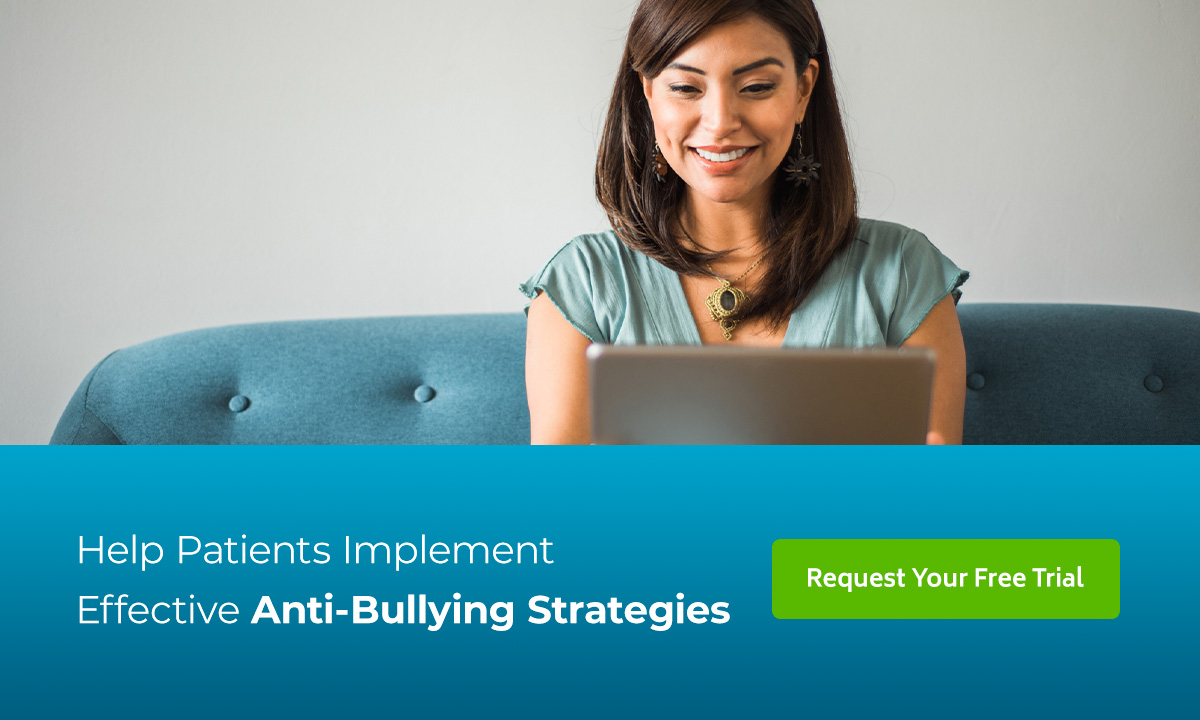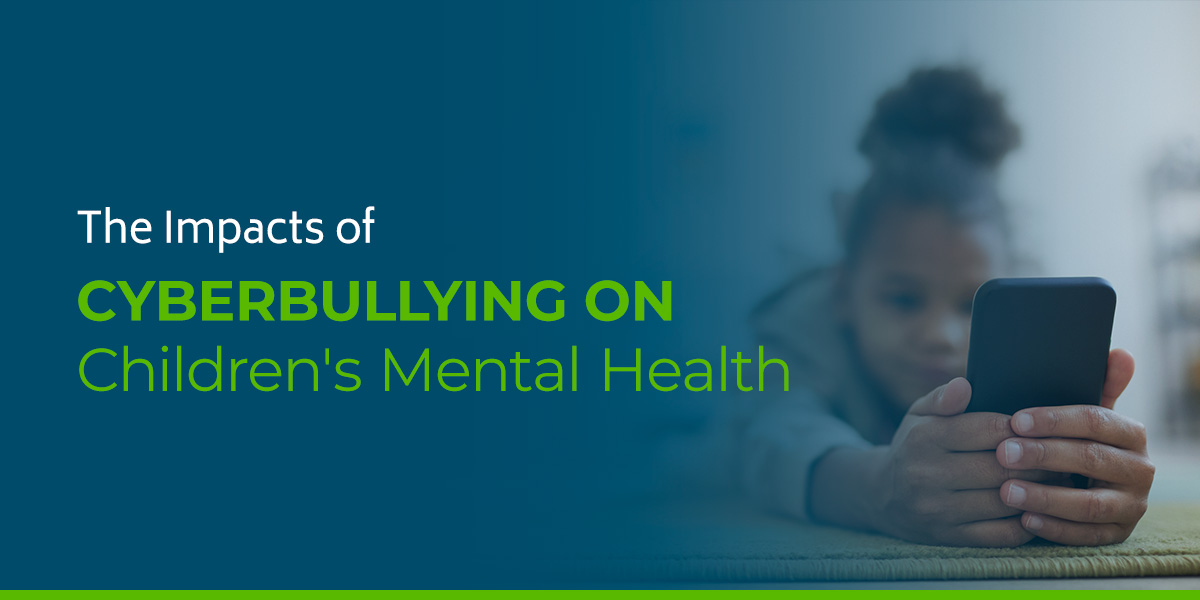
The Impacts of Cyberbullying on Children's Mental Health
According to a Stanford study, children typically receive their first cell phones between 10.7 and 12.5 years of age. Many of these phones allow children to access Wi-Fi or the internet, which means they can be exposed to social media, inappropriate online content or cyberbullying.
Cyberbullying refers to individuals who send any type of threatening or humiliating message using an electronic device. Whether it's through social media posts or text messaging, it all counts as cyberbullying. Today, cyberbullying remains an increasing concern for parents and a prominent risk for youth. In fact, research shows that parental concern about cyberbullying surpassed that of teen drug use, alcohol use and pregnancy. As a behavioral health clinician, you can help parents and educators protect kids by raising awareness and sharing cyberbullying interventions for youth.
FREE DOWNLOAD:
Provide your client families with this essential guide to online safety, tailored for parents navigating today’s digital landscape. This resource offers practical strategies to set screen time boundaries, monitor online activity, and encourage open conversations about internet safety. Download the guide to help create a healthier, safer online environment for young minds.
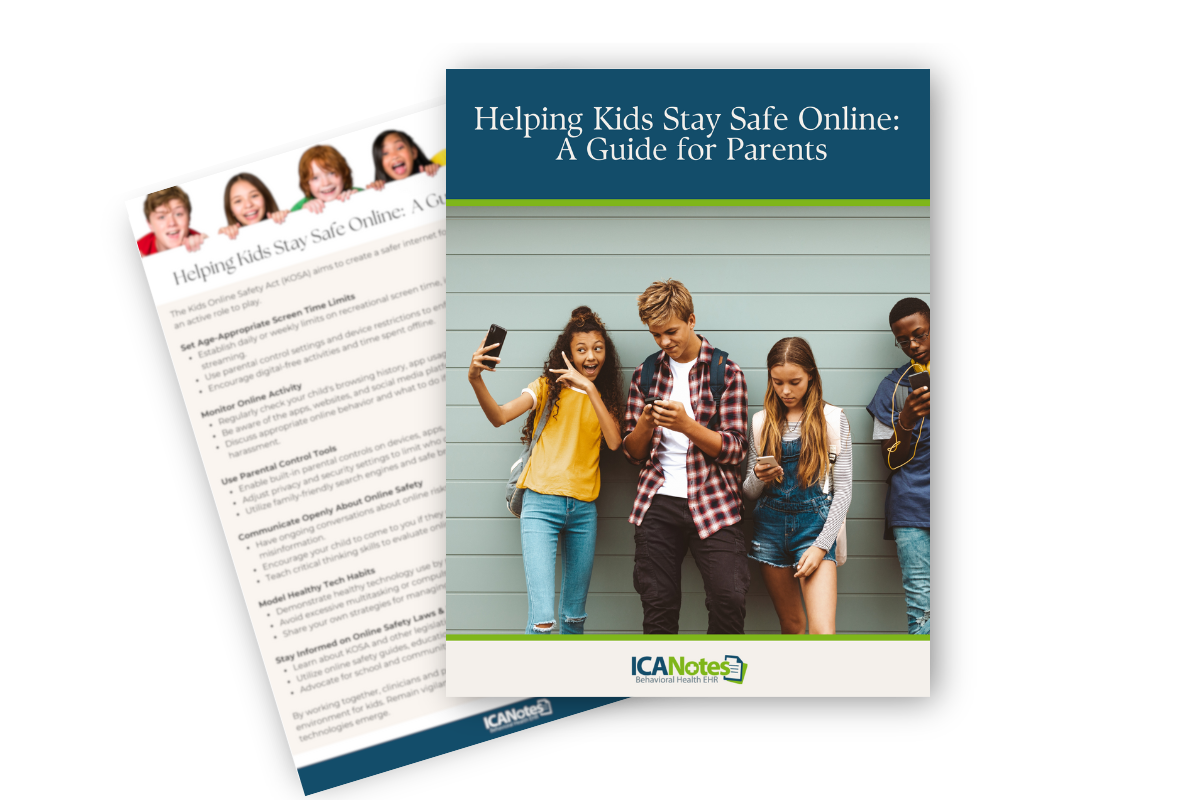
The Prevalence of Cyberbullying in Children
Nowadays, someone doesn't have to be in the same location to bully another person. Bullies can send negative and hurtful messages within seconds by simply having their cell phone number, email or social media account name.
During the 2021-2022 school year, statistics show that more than 21% of students reported being bullied online or by text. This survey shows that female students were almost twice as likely to be electronically bullied than male students. Bullying occurred more frequently online than on school buses, bathrooms and locker rooms.
According to the Pew Research Center, 46% of teens aged 13 to 17 report experiencing at least one form of cyberbullying, and 28% have experienced several types of cyberbullying. For instance, 32% said they've been called offensive names online or on their cell phones.
Likewise, 17% of youth say they've been sent explicit images they didn't ask for, while 22% have experienced false rumors spread about them online. Boys and girls aged 13 to 17 were most likely to say they were harassed or targeted online because of their physical appearance, followed by their gender, race or ethnicity, sexual orientation, and political views.
The most common platforms for cyberbullying are Facebook, Instagram, Snapchat and TikTok. However, bullies can also send direct messages to the victim or post about them in an online forum, such as Reddit.
Here are some ways to recognize teen cyberbullying:
- Colleen makes negative social media posts about her classmate, Eric.
- Katie prank calls Jessica's cell phone and leaves taunting messages about her looks.
- Taylor calls Nora names and insults her during their online game.
- Mason creates a social media post to rate the appearance or popularity of girls in his grade.
- Dylan spreads a false rumor on Instagram about Mark engaging in sexual activities.
- Jane posts a private or embarrassing photo of Julia.
- Joe sends a threatening email to Patrick after finding out they both like the same girl.
- Tate creates a fake account to impersonate Peter and hurt his reputation.
Keep in mind that this is not an exhaustive list of how cyberbullying can manifest. Various types of cyberbullying can occur through phone calls, emails, text messages, instant messages and social media comments or posts.
How Cyberbullying Affects Children's Mental Health
Cyberbullying can create long-term consequences, including poor concentration, anger, feelings of helplessness and various mental health conditions. Here are some of the most common emotional and psychological effects of cyberbullying.
1. Anxiety
Bullying in person and cyberbullying are both positively associated with anxiety, which can develop as a response to threatening or stressful situations. Research shows that victims of cyberbullying are more likely to develop anxiety compared to their peers who are not harassed online. Girls are significantly associated with higher anxiety due to cyberbullying compared to males. Individuals who are slightly older in age are also more likely to develop anxiety.
Additionally, those who experience cyberbullying victimization have an increased likelihood of developing social anxiety and appearance anxiety. Some kids feel that online harassment is inescapable, causing them to live in constant fear.
This chronic stress can lead to the development of anxiety disorders, such as social anxiety disorder (SAD), generalized anxiety disorder (GAD) and post-traumatic stress disorder (PTSD). It's important to note that anxiety caused by cyberbullying can have long-term psychological effects, and adolescents who experience cyberbullying are more likely to develop symptoms of anxiety as they age.
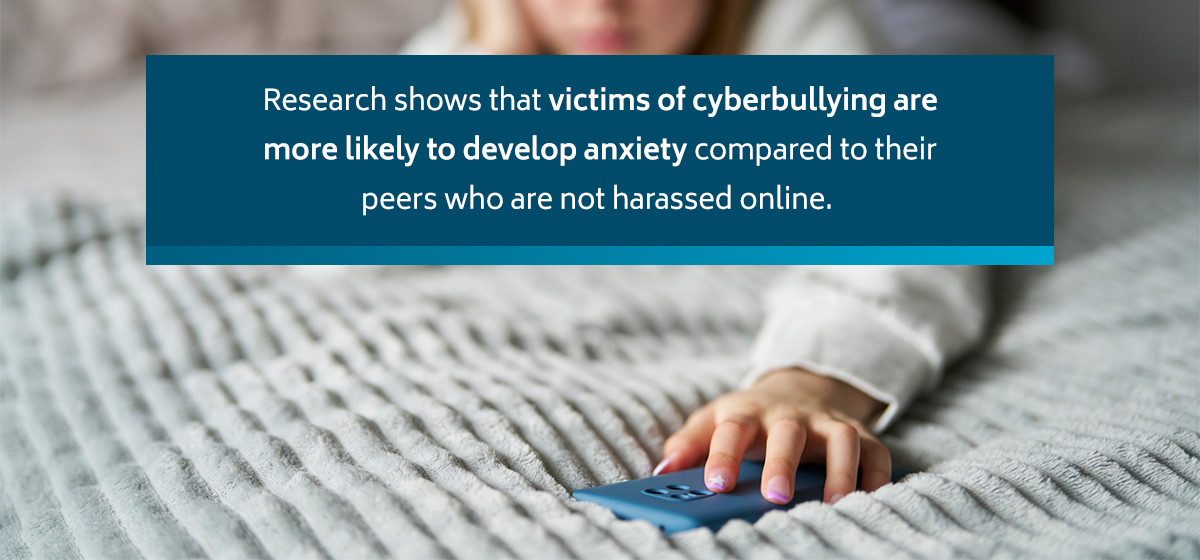
2. Depression
Another common psychological impact of cyberbullying is depression. Studies show that cyberbullying victims are at a higher risk of experiencing depressive symptoms. For example, a three-year cohort study on cyberbullying victimization revealed that about 33% of females and 16.6% of males had depressive symptoms after being harassed online. Likewise, adolescents who experienced cyberbullying were more than twice as likely to have depressive symptoms compared to those who did not.
Those involved in cyberbullying, including victims, witnesses and perpetrators, are all more likely to experience depression — including those in elementary and middle school.
3. Social Isolation
Kids who are cyberbullied are also likely bullied in shared social spaces, including school. No matter the reason for the online harassment, individuals who are cyberbullied can develop feelings of isolation and helplessness. They may only feel safe when by themselves and avoid going out with friends or engaging in extracurricular activities to prevent any chance of being bullied.
Children who are cyberbullied tend to retract their personalities and find any means of "blending" in with others to protect themselves from becoming targets, which can make it challenging to develop friendships. Cyberbullying victims report higher feelings of loneliness, and absence from school is also associated with cyberbullying.
4. Distorted Self-Image
Victims of cyberbullying report lower levels of self-esteem, or attitudes toward their persona. Repeated occurrences of cyberbullying can cause victims to internalize the negative comments they receive until they eventually believe what others say about them. In a study of the relationship between cyberbullying and self-esteem, 86% of respondents reported that cyberbullying impacted them — 78% said the bullying impacted their self-confidence, while 70% said it affected their self-esteem.
Low self-esteem has been linked to many mental health conditions, including depression and self-injury.
5. Suicide
Higher rates of anxiety and depression are significantly associated with suicidal ideation globally. The same three-year cohort study that found a link between depression and cyberbullying also revealed that those who were cyberbullied were 2.50 times more likely to experience suicidal ideation compared to their counterparts. Additionally, nearly 7.5% of females and 2.3% of males reported serious consideration for attempting suicide in the last year after being cyberbullied.
Cyberbullying is also associated with suicidal thoughts, suicidal attempts and suicide. Research reveals that both cyberbullying and adolescent suicide are increasing in the United States, with nearly 14% of adolescents making a serious suicide attempt in relation to cyberbullying.
How to Tell if a Child Is Being Cyberbullied
As a school counselor or child therapist, you must know how to identify warning signs of cyberbullying. Raising awareness about the signs of cyberbullying can also help parents and educators intervene before these situations progress. If a child is being cyberbullied, they might exhibit significant shifts in their behavior, including:
- Compulsively checking social media more often than usual.
- Being sad, withdrawn or depressed.
- Being secretive about their online activities.
- Avoiding school or social activities they used to enjoy.
- Difficulty concentrating.
- Feelings of low self-esteem or confidence.
- Disproportionate reactions of anger and frustration.
- Changes in appetite.
- Crying spells or irritability for no apparent reason.
- Difficulty sleeping or having nightmares.
- Complaints about headaches or stomachaches.
- Being unable to talk about their feelings.
- Acting nervous or jumpy when receiving a text or notification.
- Spending more time than usual in their room.
- Poor academic performance.
- Self-harm or suicidal ideation.
It's possible that some children and teens may not exhibit these signs right away or at all. More importantly, many children who are cyberbullied do not tell a parent, counselor or teacher because they feel embarrassed, ashamed or fear that their electronic device will be taken away from them. However, if a child does exhibit one or more of these symptoms, it could be a sign they're being bullied to some degree.
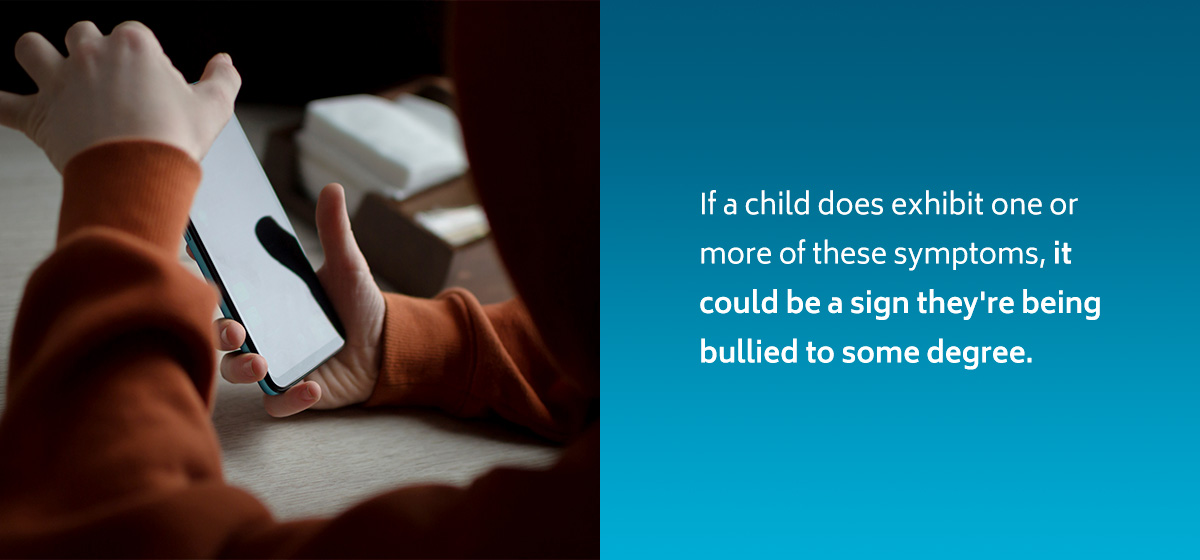
The Role of Social Media in Cyberbullying
Cyberbullying is a distinct form of bullying because it occurs through electronic devices, presenting a few advantages for bullies:
- They can hide their identities online.
- They can send persistent messages at any time, even after school.
- They can post about others on a public platform for anyone to see.
- They can more easily hide cyberbullying because it's not happening in front of teachers or parents.
Social media and cyberbullying are closely intertwined. Most social media accounts are free and easy to make, allowing kids of all ages to access any public accounts they wish and leave comments or posts at their will. The role of anonymity can empower perpetrators of cyberbullying, allowing them to feel a sense of protection against consequences, as their real identity remains unknown.
Social media can also facilitate cyberbullying, as the frequency of internet usage is a strong predictor of cyberbullying victimization. The more time kids spend online, the more likely they are to be exposed to cyberbullying or become bullies themselves.
Research indicates that many kids are aware of the role social media plays in cyberbullying. For example, 42% of teens believe online bullying and harassment can be reduced if social media companies delete harmful posts, while 50% believe locking users out of their accounts for bullying would reduce these issues. More than 35% of kids also believe cyberbullying could be reduced by requiring all users to use their real names and pictures before making an account.
Therapeutic Strategies for Addressing Cyberbullying
You can help children, teens and their parents address the long-term effects of cyberbullying in your sessions with the following therapeutic strategies.
1. Teach Responsible Online Usage
One of the top ways to mitigate the negative effects of cyberbullying is to educate parents and kids on how to make social media a safer place. For instance, parents should monitor their children's usage of social media, including the amount of time they spend online each day. Kids and parents should also learn how to block and report individuals who harass them on any platform.
Today, many social media platforms have features in place to remove potentially harmful content. For example, using insults and swear words often violates the terms of service for many websites. Inappropriate content, such as explicit photos, is also heavily monitored. However, parents can be proactive in preventing cyberbullying by adjusting the settings on their children's phones or social media accounts to protect them from certain users or content.
2. Implement Healthy Coping Strategies
Building resilience is key to coping with cyberbullying. You can help your patient deal with cyberbullying by practicing assertiveness and building their social skills. Helping them feel confident in their own abilities to overcome challenging situations can also empower them to seek help when they need it. Emotion-focused coping strategies like deep breathing, listening to music or finding a hobby that allows them to express their feelings can also help patients deal with the emotions associated with cyberbullying.
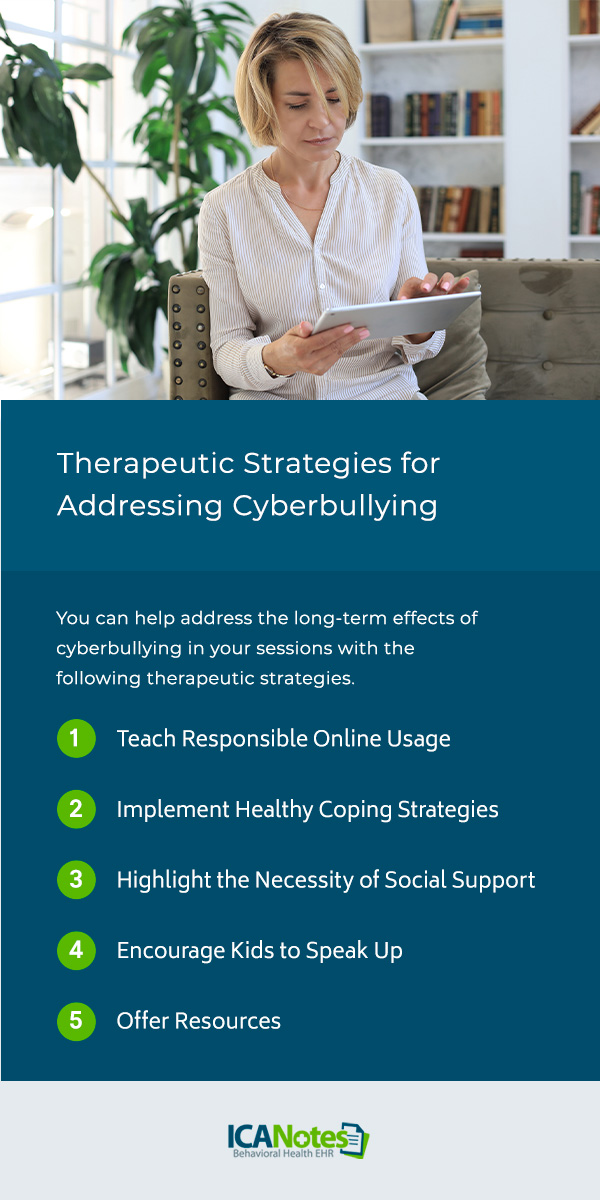
3. Highlight the Necessity of Social Support
Building a child's sense of belonging is one of the most essential therapeutic approaches to counteract cyberbullying. The value of family and peer support for a victim of bullying cannot be overstated. Your patient can combat feelings of loneliness caused by cyberbullying by talking to their friends or parents about their experiences. Leaning on loved ones for support can create a sense of community for them and help them feel relief from distress.
4. Encourage Kids to Speak Up
Many victims of cyberbullying do not want to come forward about their experiences because they feel embarrassed or fear retaliation from bullies. It's important to teach young patients to speak out to a trusted adult to put a stop to bullying. Reassure your patients that it is not their fault that they are being cyberbullied, and provide a safe, nonjudgmental environment for them to share their feelings.
5. Offer Resources
If you suspect your patient is being cyberbullied, you can do your part by encouraging them to talk about their feelings. However, if they're not ready to open up, you can still implement a cyberbullying intervention technique by passing along helpful, actionable resources. These could include contact information for reporting cyberbullying, youth-focused programs, suicide hotline numbers and information about the legal ramifications of bullying. In some cases, parents may need to report cyberbullying to the authorities.
Why Trust ICANotes?
No child or teen deserves to be bullied. As a child therapist or counselor, you can help parents learn more about cyberbullying to prevent hurtful experiences and mental health conditions in their children. Implementing the above strategies and raising awareness about the signs of cyberbullying can contribute to a more positive world for all youth.
At ICANotes, we want to help behavioral health clinicians like you create accurate, secure notes for patients. When you're in a session, you want to give your full attention and compassion to your patient. Our electronic health record (EHR) software was thoughtfully designed by fellow mental health professionals to address pain points in organization, compliance and efficiency more effectively.
Our fully templated EHR makes it easy to create thorough notes that meet state and federal regulations. Whether you're completing an initial assessment for your patient or developing a treatment plan to address their symptoms, you can create high-quality notes that make it easier to track your client's progress.

Help Patients Implement Effective Anti-Bullying Strategies
Your mental health records are invaluable for your patient's mental health journey. However, disorganized and illegible documents can make it challenging to remember key details about your client and cause confusion among their care team.
That's why our behavioral health EHR features preconfigured mental health templates and notes. You can reduce your documentation time and focus more on speaking face-to-face with clients who need your guidance. Start your free trial or book a demo online to learn how you can streamline your workflow.
Sources:
https://med.stanford.edu/news/all-news/2022/11/children-mobile-phone-age.html
https://pmc.ncbi.nlm.nih.gov/articles/PMC10558870/
https://nces.ed.gov/pubs2024/2024109rev.pdf#page=10
https://www.pewresearch.org/internet/2022/12/15/teens-and-cyberbullying-2022/
https://www.stopbullying.gov/cyberbullying/what-is-it
https://pmc.ncbi.nlm.nih.gov/articles/PMC10001909/
https://bmcpsychology.biomedcentral.com/articles/10.1186/s40359-023-01091-9
https://www.mdpi.com/2071-1050/15/13/9978
https://sites.psu.edu/aspsy/2023/11/09/cyberbullying-and-anxiety/
https://bmcpsychiatry.biomedcentral.com/articles/10.1186/s12888-022-04238-x
https://pmc.ncbi.nlm.nih.gov/articles/PMC9957368/
https://www.frontiersin.org/journals/public-health/articles/10.3389/fpubh.2021.634909/full
https://pmc.ncbi.nlm.nih.gov/articles/PMC10001909/
https://pmc.ncbi.nlm.nih.gov/articles/PMC9777360/
https://pmc.ncbi.nlm.nih.gov/articles/PMC11135207/
https://bmcpsychology.biomedcentral.com/articles/10.1186/s40359-023-01091-9
https://bmcpsychiatry.biomedcentral.com/articles/10.1186/s12888-022-04238-x
https://jaapl.org/content/51/1/112.long
https://www.aces.edu/blog/topics/home-family-urban/cyberbullying-on-the-rise/
https://medlineplus.gov/bullyingandcyberbullying.html
https://pmc.ncbi.nlm.nih.gov/articles/PMC9350190/
https://www.pewresearch.org/internet/2022/12/15/teens-and-cyberbullying-2022/

